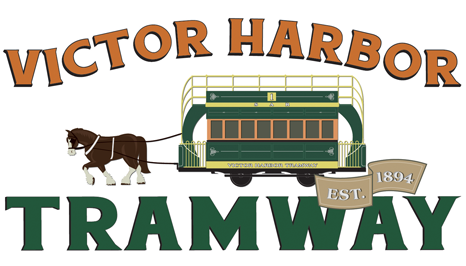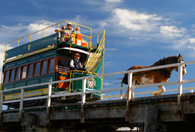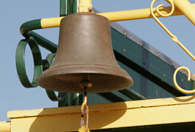1836: The New Colony
The colony of South Australia was proclaimed on 28 December 1836. Although Governor John Hindmarsh favoured Encounter Bay as the location for the new city, Colonel William Light, the Government Surveyor, insisted that the present site of Adelaide was more suitable.
1854: The First Railway
During the first two decades the transport of produce from inland to the sea for export became increasingly important to the economy of the colony. Because it was difficult and dangerous for steamers travelling the River Murray to pass through the Murray Mouth to the sea, in 1851 work commenced on the construction of a railway between the River Port of Goolwa and Port Elliot 11km away. In May 1854 the first public railway in Australia became operational. Horses were used, instead of steam engines, to contain costs.
1864: Victoria Pier
After seven ships were wrecked at Port Elliot between 1853 and 1864, it was considered too dangerous a harbour for continued use. The line was extended a further 6.5 km to Victor Harbor where it continued onto the jetty, which jutted out from Police Point. On 4 August 1864 the jetty was officially opened as Victoria Pier. Produce could now be transferred to larger ships and a stone goods shed was constructed on the mainland. It is now the South Australian Whale Centre.
1867: The Causeway
In 1867 a deputation to the Commissioner for Public Works resulted in the continuation of the original pier in a direct line to Granite Island. This extension became known as “The Causeway”. The line continued onto and around the northern edge of the island to where a Working Jetty was constructed. In 1881 an additional jetty, protected by a breakwater, was built. The Screw Pile Jetty still stands today and is used by local fishing vessels and pleasure craft.
1894: The First Horse Drawn Tram Passenger Service
For many years goods were conveyed between the mainland and the island on railway trucks drawn by horses. Many visitors to Victor Harbor delighted in the walk across the Causeway to the island. As it had become a local attraction, and the rail line already existed, the South Australian Railways (SAR) decided to utilise one of the their unused horse-drawn passenger trams to offer a service to the island. On 27 December 1894 the passenger horse tramway was established.
The First Island Tram – No. 7
The first tram to be used on the Causeway was a six-windowed double ended, double deck car built in England by “Brown Marshall” of Birmingham. It had originally been delivered to the Goolwa Railway in 1879, then transferred to the Moonta Horse Railway in 1887, then stored at the SAR’s Islington workshop from 1891 until it was sent to Victor Harbor in 1894. Car No. 7 continued in service until 1931.

Brown Marshall tram No. 7 circa 1902.
The Second Island Tram – No. 25
The passenger horse trams in Adelaide were gradually replaced by electric trams from 1909 onwards. Tram No. 25 was purchased from the Municipal Tramways Trust (MTT) and transferred to Victor Harbor to support No. 7 in service to the island. It was built by Adelaide and Suburban Tramway company around 1900/ It was converted from standard tramway gauge (1435mm) to railway broad gauge (1600mm) by mounting axle boxes to a wooden unperformed which protruded from the sides of the body panels. No. 25 joined No. 7 in 1910 until its retirement in 1929.

No. 5 departs the Victor Harbor terminus.
1931: Trams No. 5 & No. 6
When the Moonta Tramways closed in 1931 the two trams of best condition were towed by a railway line inspection car to the Islington Workshop for overhaul. They were standard SAR six-windowed ‘American’ type double ended, double-deck broad gauge horse trams. The wheel bases were imported from John Stevenson of New York, U.S.A. and they were built by Duncan & Frazer of Adelaide in 1883. Both continued in service until the mid 1950’s.
1900-1954: The Honeyman Brothers
George Honeyman operated the service, under a contract with SAR, from the beginning of the 1900s until 1940 when his younger brother Frank took over and operated t until closure in 1955. The horses were kept in stables on Seymour lane and walked to the trams, which were parked on a siding behind the Station Master’s house. The cars were parked in the open and exposed to the elements. When an extra long railway train was in town the cars were even parked on the Causeway. So, every two years they were towed to Islington for overhaul during winter.

The biggest steam locomotive built in the UK, Engine 505 dwarfs No. 5.

Early 1950s No. 5 heads back to mainland at speed.
During the early 1950s Frank Honeyman and Mayor William Jenkins had a number of differences about the operation of the tramway. The old Working Jetty and the remnants of the Victoria Per were being demolished by the Harbour’s Board. At the time essential repairs to the Causeway were decided upon, but to strengthen the Causeway for continued operation of the tramway required an additional expenditure of 3,000 pounds.
Frank Honeyman stabled the horses for the last time in June 1954 and then retired. The Council offered the service at tender but there was no interest. The Causeway was reconstructed without rails and the Horse Drawn Tramway came to an end.
Tram No. 5 continued to operate on the remaining Granite Island tracks through the summer of 1955-56, under the ownership of the proprietor of the kiosk. It was finally put on static display, at the approach to the Screwpile Jetty, where it remained until the weather and vandals reduced it to a public danger. Sadly, it was disposed of by being pushed off the edge into the sea!
Tram No. 6 was purchased by Raymond Schmidt, an American who had ridden the tramway during the war years. In 1971 he found it on display at a service station in Auburn. It is now restored as a single deck and is featured in his museum in Connecticut, USA.

No. 6 on Granite Island during WWII.

Children photographed on tram c1940s.
Fond Memories
The stories that people tell about their memories of the Horse Drawn Tramway are as interesting as they are varied and touching. Some are from a long time ago, when they came as children to ride upon the tram and were be photographed by their parents. Then they returned as courting couples, or on their honeymoon, and have stories and photos of their visit. Then they came for Summer vacations with their own children over many years… and today they return with their grandchildren.
It is no wonder that the Victor Harbor Horse Drawn Tramway has become a significant South Australian icon and a fond memory of many visitors.
Children photographed on tram c1940s.
The Tractor Train
In December 1956 Keith Roney commenced a tractor powered, rubber tyred train service on the reconstructed Causeway.
He was succeeded by Jack Edwards and then later by Arnold Stringer who mocked-up a Land Rover to look like a steam engine. This operation continued until the Horse Drawn Trams were reincarnated in 1986.

Mr. Kieth Roney’s Tractor Train.
1980-1985: Reinstatement of the Horse Drawn Tram
1986 marked the 150th Jubilee of South Australia. Plans for special projects, events and celebrations wee being laid in the early 80s through the establishment of a Jubilee 150 Board.
John Drennan, State Transport Authority (STA) Public Relations Officer, was one amongst many who felt that Victor Harbor did not seem the same to holiday-makers without the Horse Drawn Trams of old. He registered the tramway reinstatement as a Jubilee event and gained it official consideration. The victor Harbor Council were in favour, but not financially able to fund it alone. When Bob Barry succeeded as District Clerk and threw in his support other entities made significant contributions. The Jubilee 150 Board allocated $50,000, the Commonwealth Employment Program supplied $150,000 for labour and materials, Australia National (Railways) came forward with second hand railway lines and spoked wheels for the trams, and the Victor Harbor Council was able to allocate $200,000. The Department of Marine and Harbours spent $170,000 upgrading the Causeway to a safe standard.
The Trams

Coach builders no longer existed, which posed a dilemma. Basic line illustrations and photographs of trams from the same era as No. 7 and No. 25 formed the basis of a new design. The new trams would be made of tubular steel with timber cladding and use roller bearings in custom axle boxes. They would also accommodate 50 adults as opposed to 32 on the old trams.

The project began in February 1986 with two teams of ten people. One team built the four new trams at Port Adelaide, while the other team laid the truck and constructed the stables, fencing and an enclosure at Victor Harbor.

The bare coachwork of the new tram..
Mirko Crafts were contracted to do the carpentry work and according to Kim Bayly, who did the paintwork on all four trams, praised ‘Mirko’, the owner of the business, as a true craftsman. Three-pack automotive paints were used to counter the harsh marine environment that the trams would be subject to during service.

The finished replica of Tram No. 1 on the big day.
The paint work on the first tram, No. 1, was completed over 3 weeks in the Goods Shed in Victor Harbor. This is the current location of the SA Whale Centre. Tram No. 2 arrived only a week before the scheduled grand opening. Trams No. 3 and No. 4 arrived later in the year, but No. 1 and No. 2 were fully prepared for the big day, 14 June 1986.
The Grand Opening
Hope moves off and parts the crowd. Kim Bayly at the reins with Hope. A grand opening it was too, with official guests and many of the public in period costume, the sparkling new trams, the horses groomed and in fine form, and many hundreds of spectators cheering them on that fine, sunny winter day.







